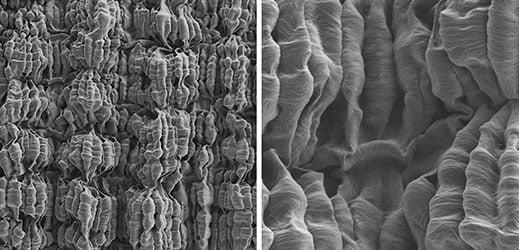Ridiculously Elastic Conductive Fibers for Stretchable Circuits
It’s hard to know exactly how technologists might use electrically conductive fibers that can perform at a high level even when stretched to 15 times their length. But it’s possible the fibers, unveiled today by an international group of researchers, could help open new applications in robotics, find use in exoskeletons, make their way into new kinds of textiles, or bring power to sensor arrays that monitor the structural health of important curved surfaces like those on the outside of aircraft.

Lots of progress has been made in recent years toward new kinds of electronic devices that can bend, flex, and stretch. But the creators of the new fibers say there is still a need for better elastic conducting materials to serve as wires, sensors, and for use in deformable energy storage devices and displays.
The new fibers, made by wrapping carbon nanotube sheets (see “Light-as-Air, Heatproof Nanotube Muscles”) around a rubber core, are relatively inexpensive and straightforward to manufacture, says Ray Baughman, a professor of chemistry and director of the Nanotech Institute at the University of Texas at Dallas. Baughman, who led the research, says they could be particularly useful for things like extendable robotic arms, or as the basis of sensor arrays that monitor the state of aircraft that “morph” to adapt to changing flight conditions.
To make them, the researchers first stretched rubber fibers to 15 times their length, before wrapping the nanotube sheets around them. When they released the stress, the individual nanotubes buckled, like accordions. When stretched again, the sheets buckled, in a different way, to account for the circumference of the rubber core shrinking as the fiber elongated. The degree to which they can stretch without losing their high conductivity is a vast upgrade over any previously demonstrated elastic conductor, according to Baughman.
One potential application of these fibers is super-stretchy charger cords for consumer electronics, says Baughman. He says next he’d like to put the new stretchy materials into textiles that could perform various electrical functions. No word yet on whether that will include pants that stretch when they sense that their wearer has put on a few pounds.
Keep Reading
Most Popular
Large language models can do jaw-dropping things. But nobody knows exactly why.
And that's a problem. Figuring it out is one of the biggest scientific puzzles of our time and a crucial step towards controlling more powerful future models.
The problem with plug-in hybrids? Their drivers.
Plug-in hybrids are often sold as a transition to EVs, but new data from Europe shows we’re still underestimating the emissions they produce.
Google DeepMind’s new generative model makes Super Mario–like games from scratch
Genie learns how to control games by watching hours and hours of video. It could help train next-gen robots too.
How scientists traced a mysterious covid case back to six toilets
When wastewater surveillance turns into a hunt for a single infected individual, the ethics get tricky.
Stay connected
Get the latest updates from
MIT Technology Review
Discover special offers, top stories, upcoming events, and more.